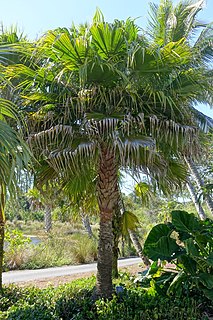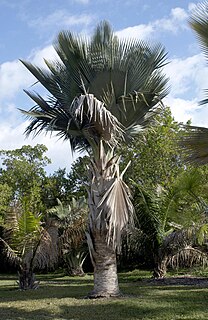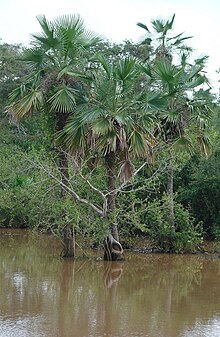
Bromus tectorum, known as downy brome, drooping brome or cheatgrass, is a winter annual grass native to Europe, southwestern Asia, and northern Africa, but has become invasive in many other areas. It now is present in most of Europe, southern Russia, Japan, South Africa, Australia, New Zealand, Iceland, Greenland, North America and western Central Asia. In the eastern US B. tectorum is common along roadsides and as a crop weed, but usually does not dominate an ecosystem. It has become a dominant species in the Intermountain West and parts of Canada, and displays especially invasive behavior in the sagebrush steppe ecosystems where it has been listed as noxious weed. B. tectorum often enters the site in an area that has been disturbed, and then quickly expands into the surrounding area through its rapid growth and prolific seed production.

Copernicia baileyana (yarey) is a palm which is endemic to eastern and central Cuba. Like other members of this genus, C. baileyana is a fan palm. Trees are 10 to 20 metres tall with stems 40 centimetres in diameter and are sometimes swollen. The fruit is black, 1.8 to 2.3 centimetres long and 1.8 to 2 cm in diameter.

Copernicia berteroana is a palm which is endemic to Hispaniola; it is also reported from Curaçao and Venezuela, but it is probably naturalized there.
Copernicia brittonorum is a palm which is endemic to western and west central Cuba.
Copernicia cowellii is a palm which is endemic to Camagüey Province, Cuba.

Copernicia curbeloi is a palm which is endemic to Cuba.

Copernicia curtissii is a palm which is endemic to Cuba.
Copernicia ekmanii is a palm which is endemic to northern Haiti.

Copernicia fallaensis is a palm which is endemic to Cuba.
Copernicia gigas is a palm which is endemic to eastern Cuba.

Copernicia glabrescens is a palm which is endemic to western and west central Cuba.

Copernicia hospita is a palm which is endemic to Cuba.
Copernicia humicola is a palm which is endemic to Cuba.
Copernicia longiglossa is a palm which is endemic to eastern Cuba.
Copernicia molineti is a palm which is endemic to Cuba.

Copernicia rigida is a type of palm endemic to eastern and central Cuba.
Copernicia roigii is a palm which is endemic to Cuba.
Copernicia yarey is a palm which is endemic to Cuba.

Elegia tectorum, previously Chondropetalum tectorum or Restio tectorum, more commonly Cape thatching reed, or dakriet, is a member of the restio family, Restionaceae. It is a tufted perennial growing to between 1.5 and 2.25 m, with deciduous leaf sheaths. Flowers are less than 3 mm long. Petals are smooth or hairy in the upper half. E. tectorum is found in marshes and seeps on deep sand in the Western Cape and Eastern Cape of South Africa.










